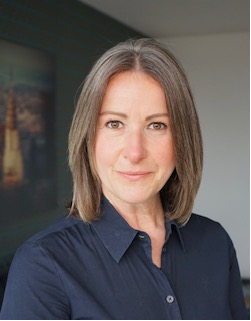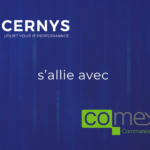
At the head of a BU that represents almost a third of Lucernys’ activity, Aude Couradjut looks back at the specificities of the IT recruitment business, especially in times of crisis. This diagnosis remains optimistic for the profession, characterized by a refocusing on projects with high ROI, including FinOps and digital transformation. Overview of best practices and success levers for IT sourcing.
How would you define your sourcing job today?
Aude Couradjut: Sourcing is defined as any act of searching for and directly approaching people and talents in order to meet a recruitment or staffing objective in relation to missing resources.
In short, it’s democratized headhunting. And the imperative today is to be able to respond in a short, efficient and relevant timeframe with regard to the research entrusted to us.
What makes sourcing in the IT sector so special compared to other sectors?
Aude Couradjut: The specificity is linked to the particularities of the IT businesses we address. We know the players involved in projects, tools and solutions. We are forced to have a perfect understanding of both our customers’ challenges and the major players in the digital transformation. This requires knowledge of operators, integrators, ESNs or specialized consulting firms and a constant eye on Gartner.
Successful IT sourcing requires a detailed knowledge of the issues and players
We also need to be able to learn, retain, list and assimilate in a market where, whatever the sector of activity – retail, banking, insurance, distribution, services, agri-food, etc. – we need to be able to know in record time the competitors, the major players, the operators and the cross-functional businesses that coexist. It is then the guarantee to find for our customers who are looking for potentials and experts, profiles targeted on a first answer.
All this in a context that is evolving very quickly, with technologies that are also evolving very quickly?
Aude Couradjut: The strength of IT sourcing, in reality, lies in the extent of the general culture that we can have on these subjects. Very often our customers are sensitive to the reactivity with which we can produce our missions thanks to a good control of the subjects which are entrusted to us, and our capacity to know how to surround ourselves if in the contrary case, we do not master or less the subject. And our role is to support our customers in making their decisions, because the market demands speed. Successful sourcing is the combination of good practices, knowledge of both the customer’s challenges and the market, and the ability to intervene by aligning all those who will see an immediate benefit in effective sourcing.
How are your offering and sourcing activities organized at Lucernys?
Aude Couradjut: It is based on 3 main activities:
- A fee-for-service activity – in other words, the delegation of resources that consists of :
- join an ESN or one of our recurring partners, in subcontracting. We address ourselves to this first relay;
- Lean on a network of independents that we already know or will hunt. It takes a little more time because you have to source an independent profile or contact them on reference. You have to be able to interest them by arousing a particular interest – they are chased on average 5 to 10 times a day -, to meet them, to validate them technically, in terms of personality and culture, and sometimes in terms of the client’s requirements. All these elements – personal, cultural, and of course technical – must be reconciled with our clients’ requirements.
- Call on interim management to lead a transition, manage a difficult situation, accompany a reorganization, compensate for an absence or while waiting for a recruitment.
You have to interest hunted candidates up to 10 times a day
- We also have a headhunting and recruitment activity. This service allows us to accompany our clients through the entire process and methodology of a recruitment agency (without exclusivity, success fees and fixed fees) in relation to a job creation/opening in their company.
- The third service – which can be combined with the two previous ones – is pre-hiring. This means that the client is open to recruitment, but needs to validate the profile technically and its ability to integrate its teams. For this purpose, it chooses to use a 3 to 6 month service, sometimes renewable, in order to internalize this profile.
How would you describe the IT sourcing market today?
Aude Couradjut: Today it requires a great deal of intellectual mobility and a certain agility, not technical, but in terms of research and alignment of objectives. Our clients need to be supported in this flexibility. Digital transformation therefore requires support and advice. It is often thought that to transform, you have to take two steps forward to take one step back. This phenomenon is amplified by the number of players to be brought together.
Recruiting change facilitators
There are sometimes internal obstacles: fear of the unknown, difficulty in changing methodology. In order to implement a solution, users sometimes find it difficult to accept the idea of wasting time because they fear that they will not succeed, that the tool will not be effective, that it will be difficult to learn. There are a lot of parameters that they are struggling with.
What best practices would you recommend for successful recruitment?
It is important not to wait until a research line is underway to create a methodology. This is obviously done upstream.
At Lucernys our intervention, sometimes a little disruptive to our customers, is characterized by its speed. They are sometimes amazed at the speed at which we intervene. But that’s because we have key success factors that allow us to move quickly. Good practices include:
- the personalization of the contact
- the use of a recommendation from someone in their network.
- the tone of the exchange: for example, we call the candidates by their first name; while respecting them, we demystify the relationship and sometimes we challenge them more by calling them by their first name,
- …and the smile, it counts a lot!
We demystify the relationship with open questions
In short, we try to refer to something that demystifies the relationship a bit. We avoid “are you looking for or listening to the market” in favor of “what areyou missing today in your position?” “What makes us here today, talking to each other? With an open-ended question, people open up much more.
With telecommuting, aren’t there more pressing needs for dematerialization of workspaces, and therefore for dedicated recruitments?
Aude Couradjut : Not necessarily. Instead, we worked on redesign, rationalization, project management and PMO projects, i.e. securing and supervising project portfolios. We intervened on the network, security, but not more than usual. We have mainly been involved in project portfolio management requests because there is this very stakeholder group in finance that is looking to rationalize costs. On the “sourcing and interim management” side, there is more and more interest for finance and operations departments to identify where it is possible to make money, particularly on the FinOps side, but also on project portfolios and major transformation programs.
Our clients closely monitor and focus their financial efforts on projects that are key to the company’s strategy. Priority is given to projects that generate cash or ROI at the expense of those that are less so.
The crisis has favored FinOps and ROI generating projects
Digital transformation programs can reveal real levers for improving customer service, consolidating margin reports, accessing key information or data for marketing and, ultimately, proposing a more relevant offer.
Today, the profiles sought are generally cross-functional to IT, Operations, Research and Finance, which will support the General Management and companies undergoing transformation that need to restructure their offer on certain business rules, on the detection of productivity gains, and the identification of short-term growth levers, despite the pandemic context.
We have had projects around digital workplaces or virtual offices but they have not exceeded 50% growth. Most of the profiles of the moment are PMO, finance consultants, mixed consultants: transformation, delivery and project management.
How do you manage to retain profiles in this penurious market?
Aude Couradjut: On the management side, we are very present and very involved in the monitoring of the mission, through steering committees or more informal contact. This allows us, it is true, to have little turnover or abandonment of mission – around 3 to 7% – among our consultants in mission sometimes for 3 years. Only 2% are truly related to casting errors, so the ratio is pretty good.
Loyalty is built by listening, following up and paying attention. We are also very present on the information we provide them. If the mission is not going well or if there is frustration, they have our ear. We are able to encourage them to hang in there and if things get really difficult, we keep a constant link to get them to work elsewhere if necessary and anticipate an exit very quickly.
To retain our consultants, we must be very present
All this implies being very present. And yet, we work with teams that are often considered “mercenaries”. It is often thought that these independents can leave overnight. In fact, if they are found an assignment – not too far away – that satisfies them and they listen to the client, they are delighted. They don’t have time to trade. And leaving a mission overnight is very complicated.
Loyalty sometimes comes from team dynamics
Most of the consultants we work with are involved in strategic projects. In close contact with the CIO, they collaborate on programs worth 20 or 30 million euros. This brings value and, by rebound, enhances their career. They can sometimes evolve within these projects and build teams by sharing their expertise.
When you’ve managed to put together a project team and you’ve managed to create that magic of creating relationships – people who didn’t know each other, who work together, who become friends, who see each other outside of the office and who invite you to a team member’s birthday party… – you know you’ve succeeded.
Strengthened ties during confinement
We had the case, at the time of containment, of a program director who had difficulty mobilizing his teams to work together at a fairly remote site. He discovered that half of his team lived in western Paris, like him. Finally, they organized rounds of the table in each other’s homes, respecting distances and barrier gestures.
Loyalty can also come through these channels.
What recruitment challenges do you identify in digital transformation projects?
Aude Couradjut: Among the challenges, it is important to find resources capable of taking on the role of accompanying the people who have recruited them. This is the case for interim managers. Candidates or consultants can do this coaching. They have the ability to share feedback and to lead these managers in their transformation in the best possible way. They are contributors to the success of the transformation project.
Sourcing interim managers to facilitate digital transformation
This is an issue for interim managers and profiles that would be described as a bit “above” the CIO or project team. To be accompanied by someone who is better and to pay for the resources ofa super consultant that we could not afford full time, it is a strong issue.
The ambition is to have a profile that will allow us to go one step further and access an industrialized mode of transformation. At the same time, it is a profile that will be able to carry out the mission while matching the culture and values of the company, while respecting the rhythm of the company.
Someone who goes too fast, comes into contact with obstacles and will not be listened to, therefore will not be followed.
The one who goes too slowly, will not win the support either.
What do you think are the key factors for successful recruitment?
Aude Couradjut: As we have seen, it is very much a question of how to attract talent at the point of contact. You have to understand what they’re doing – and show them that you understand what they’re doing – always ask them these open-ended questions. This is a matter of methodology. A proven methodology, shared by hunting firms with a very pragmatic approach, experienced in the difficulties linked to the shortage of candidates.
Having worked in IT since 1995, I have always been confronted with this reactivity which requires to move forward, to have a capacity of detection of good profiles, and to discern between the impostors – very present – and the very good candidates.
Be able to discern good profiles from imposters
We all share this methodology and its daily adaptation. We know how to make ourselves understood by the people who call us. We are able to show resources that we know the market, that we are there to provide an answer to the question, “What are you missing today in your job?” We can answer because we work with end customers, with very different customers, in a penurious market.
We have a certain kind of agile mindset and a “fit” culture to be able to get noticed and listened to by our clients and candidates.
What is an example of a client case to illustrate the type of work you do?
Aude Couradjut: Our client Sysco is a concrete example of the efficiency of the candidate-client relationship. You can consult this case of IT sourcing support from Sysco here. As for the CIO of Sysco, he left for Auchan Retail in Villeneuve-d’Ascq in 2020. But our story will continue. I am committed to this!







